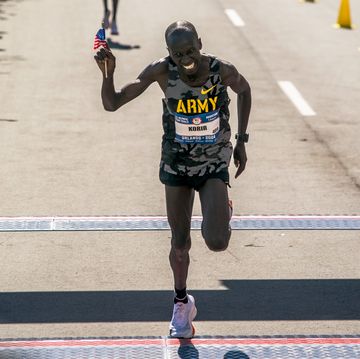- A recent study, published in Nature Communications, found that fatigue may be in your head, at least partially.
- Researchers found that people tended to avoid risk when it came to powering through, even when tired.
- In this future, this research may lead to developing cognitive strategies that could change how perceive effort is perceived, possibly making efforts feel less fatiguing.
Whether you’re inside on the treadmill or outside for a long run, that dreaded moment where you hit the wall—the one where you just can’t seem to power through—feels the same.
As it turns out, a part of that fatigue may be all in your head. And knowing exactly where it occurs in the brain could drive performance-boosting therapies in the future, according to a recent study in Nature Communications.
Researchers recruited 20 study participants and asked them to grasp and squeeze a sensor repeatedly, varying their level of effort from minimal to maximum force. Using data from MRI scans and computer modeling, they found that feelings of fatigue seem to arise from the motor cortex—the area of the brain responsible for controlling movement—according to study co-author Vikram Chib, Ph.D., assistant professor of biomedical engineering at the Johns Hopkins University School of Medicine.
As an additional measure to determine how this affects the brain’s function, researchers offered participants two choices for continuing. One was considered more “risky,” setting the amount of effort based on a coin flip that offered the chance to exert either no effort or a predetermined effort level. The “safe” choice was just the predetermined level.
By introducing uncertainty, researchers were able to see how much each participant valued their effort. That offered insight into whether people would choose to power through, even when fatigued.
“Unsurprisingly, we found that people tend to be more risk-averse to avoid effort,” Chib told Bicycling. All but one of the participants chose the safe option, and scans indicated that for everyone, the motor cortex was deactivated during the decision-making process.
Chib said this falls in line with previous studies indicating that when people become fatigued, motor cortex activity declines, which can lead to fewer signals being sent down to the muscles, leading to a reduction in power during a hill workout, for example.
Will these findings lead to hacking the motor cortex so bonking becomes a thing of the past? Not quite yet, but it’s also not impossible.
“We think we might be able to use noninvasive brain stimulation to make motor cortex activity align with an individual’s expectations of performance,” said Chib. “Another thing we might be able to do is introduce cognitive strategies that could get people to change how they perceive effort, and this might influence motor cortical activity and make efforts feel less fatiguing.”
Join Runner’s World+ for more performance-boosting health news!
Elizabeth Millard is a freelance writer focusing on health, wellness, fitness, and food.













